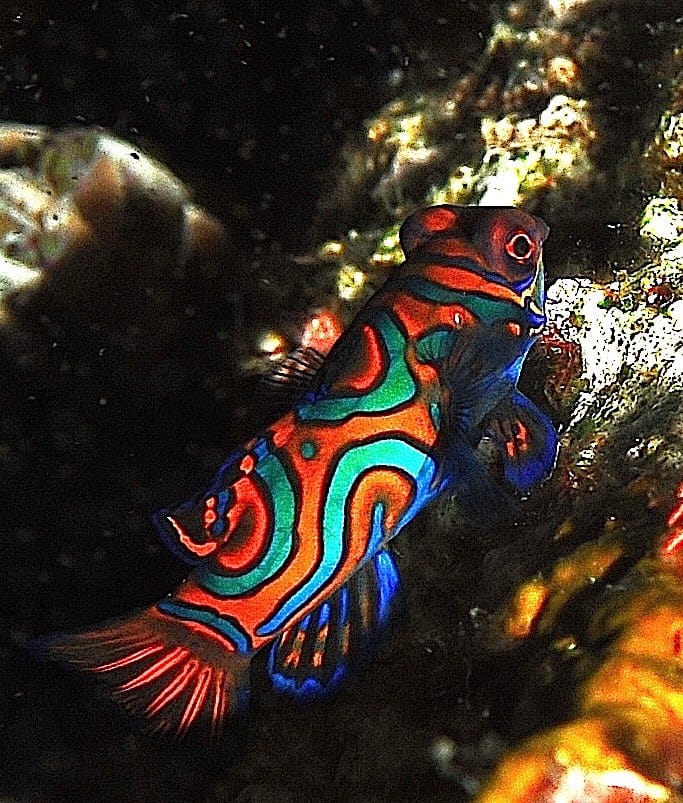
Table of Contents
Introduction
The Mandarinfish Palawan (Synchiropus splendidus), also known as the Mandarin Dragonet, is one of the most spectacular and vividly colored fish in the world. Found in the tropical waters of the best diving Philippines, this small yet mesmerizing species is famous for its intricate patterns and unique mating dance, making it a highly sought-after sight among divers and underwater photographers.
Palawan, particularly the Coron to El Nido route, offers incredible opportunities to witness the Mandarinfish Palawan in its natural habitat. However, due to habitat destruction and overcollection for the aquarium trade, its population is declining, making responsible diving and conservation efforts crucial.
This guide will explore everything you need to know about the Mandarinfish Palawan, including its habitat, behavior, conservation status, and the best dive spots to see it in the Philippines.
Scientific Classification and WoRMS Reference
The Mandarinfish Palawan (Synchiropus splendidus) belongs to the Callionymidae family, a group of small, bottom-dwelling fish known as dragonets. According to MarineSpecies.org (WoRMS), it is classified as follows:
✔ Scientific Name: Synchiropus splendidus
✔ Family: Callionymidae
✔ Order: Perciformes
✔ Class: Actinopterygii
✔ WoRMS Reference: MarineSpecies.org – Synchiropus splendidus
📍 Why It’s Important: MarineSpecies.org (WoRMS) is the leading global database for marine species, ensuring accurate and scientifically validated data on the Mandarinfish Palawan.
What Makes the Mandarinfish Unique?
1. Stunning Colors and Patterns
✔ Covered in electric blue, green, orange, and yellow patterns, making it one of the most colorful fish in the ocean.
✔ Unlike other fish, it lacks scales and has a slimy mucus coat that protects it from parasites.
✔ Only grows up to 6-7 cm (2.5 inches), making it a small but eye-catching species.
📍 Fun Fact: The Mandarinfish’s vibrant colors act as a warning signal to predators, indicating that it has toxic skin secretions.
2. Unique Mating Dance
✔ Every evening at sunset, Mandarinfish perform an incredible courtship display.
✔ Males and females rise together from the reef, spiraling upwards in a beautiful synchronized motion before releasing their eggs.
✔ This ritual lasts only a few minutes, making it a rare and exciting sight for night divers.
📍 Best Time to Witness the Mating Dance: Right after sunset, between 6:00 PM – 7:30 PM.
3. Habitat and Depths in Palawan
✔ Typically found in shallow coral reefs and lagoons, at depths ranging from 3 to 18 meters.
✔ Prefers calm, sheltered areas with dead coral rubble, where it hides during the day and emerges at dusk.
📍 Best Diving Conditions: November to May, when visibility is clearest.
Where to Find the Mandarinfish in Palawan?
1. Coron – Hidden Reefs and Calm Lagoons
✔ Best for: Macro photography, shallow reef diving, and night dives.
✔ Mandarinfish Sightings: Often found in small coral crevices and sandy bottoms.
✔ Best dive sites: Siete Pecados, Twin Lagoon, Lusong Coral Garden.
📍 Why It’s Special: Coron is famous for its shipwrecks, but its calm reefs also provide a safe habitat for Mandarinfish.
2. El Nido – Shallow Coral Gardens and Seagrass Beds
✔ Best for: Reef diving, shallow snorkeling, and night diving.
✔ Mandarinfish Sightings: Typically seen hiding in coral rubble near sandy slopes.
✔ Best dive sites: South Miniloc, Twin Rocks, Dilumacad Tunnel.
📍 Why It’s Special: El Nido’s marine reserves ensure a thriving population of Mandarinfish, making it a top location for night divers.
Conservation and Responsible Diving Practices
Although the Mandarinfish Palawan is not officially endangered, habitat destruction and the aquarium trade threaten its survival.
Conservation Efforts in the Philippines
✔ Marine Protected Areas (MPAs): Palawan has designated several MPAs to protect coral reefs and Mandarinfish habitats.
✔ Sustainable tourism programs: Local dive centers promote responsible diving and marine conservation.
✔ Scientific research: Organizations like MarineSpecies.org (WoRMS) track population trends and ecosystem health.
📍 How You Can Help:
- Avoid touching the reefs to protect Mandarinfish habitats.
- Support eco-friendly dive shops that follow sustainable tourism practices.
- Educate fellow divers on responsible night diving techniques.
FAQs About Mandarinfish Palawan
1. Why are Mandarinfish so colorful?
✔ Their vibrant patterns act as a warning to predators, signaling that they produce toxic skin secretions.
2. Can I see Mandarinfish while snorkeling?
✔ Yes, but they are easier to spot while night diving, as they hide during the day.
3. What is the best diving Philippines site to see Mandarinfish?
✔ Coron to El Nido offers some of the best Mandarinfish habitats, especially in shallow lagoons.
4. How do Mandarinfish reproduce?
✔ Males and females perform a short mating dance at sunset, releasing eggs into the water.
5. Is the Mandarinfish collected for aquariums?
✔ Unfortunately, yes. Many are captured for the aquarium trade, leading to population declines in some areas.
6. What’s the best way to photograph a Mandarinfish?
✔ Use a macro lens and be patient—they are shy and move quickly.
Conclusion
The Mandarinfish Palawan is one of the most beautiful marine species in the best diving Philippines. Divers exploring the Coron to El Nido route have the rare chance to witness its stunning colors and unique mating ritual.
By practicing responsible diving, avoiding reef damage, and supporting conservation efforts, we can ensure that the Mandarinfish Palawan thrives for future generations.

